'I worked out in virtual reality for 7 days, here’s what I learned’
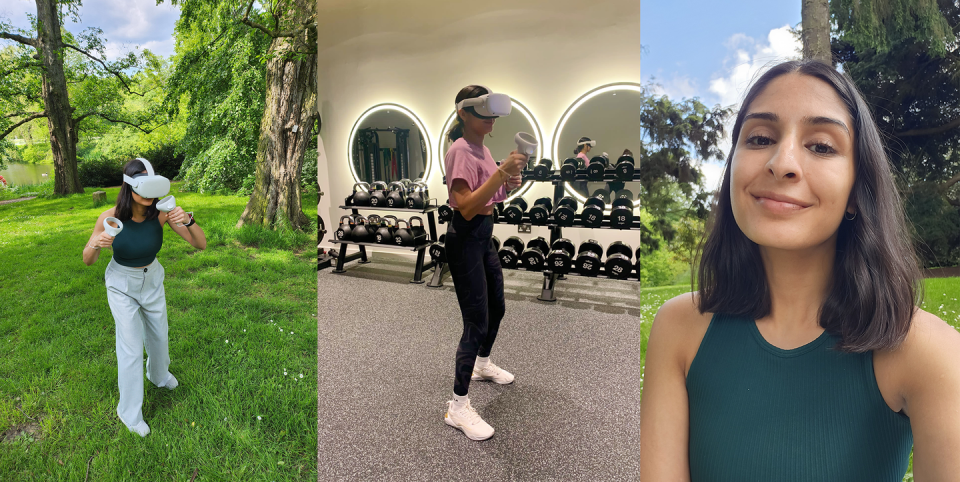
PSA: Right now, you can get a massive £150 off the Meta Quest 2. Ready to take your home workouts to the next level?
There’s not much I won’t try in the name of health and wellness. Under-desk-treadmills, fitness retreats, even the 75 Hard challenge... I’m open to anything that promises a stronger mind and body. So, when the opportunity to test the Meta Quest 2 virtual reality headset and work out in the metaverse for a week came up, naturally, I was all in.
VR workouts are set to become the next big thing in the fitness world, with the global virtual fitness market expected to reach a mega $106.4 billion by 2030, and is it any wonder? The pandemic changed the way we exercise for good, with many of us still opting for home workouts over spenny gym memberships.
Although exergaming is nothing new (remember the Nintendo Wii Fit days of the noughties?), now brands are taking things one step further by offering virtual workouts complete with immersive music, graphics and tactile cues to transport you into a whole other world. From throwing punches on the moon to meditating in the Himalayas, it’s all possible with a VR headset and a little bit of space on your living room floor.
What are the benefits of VR fitness?
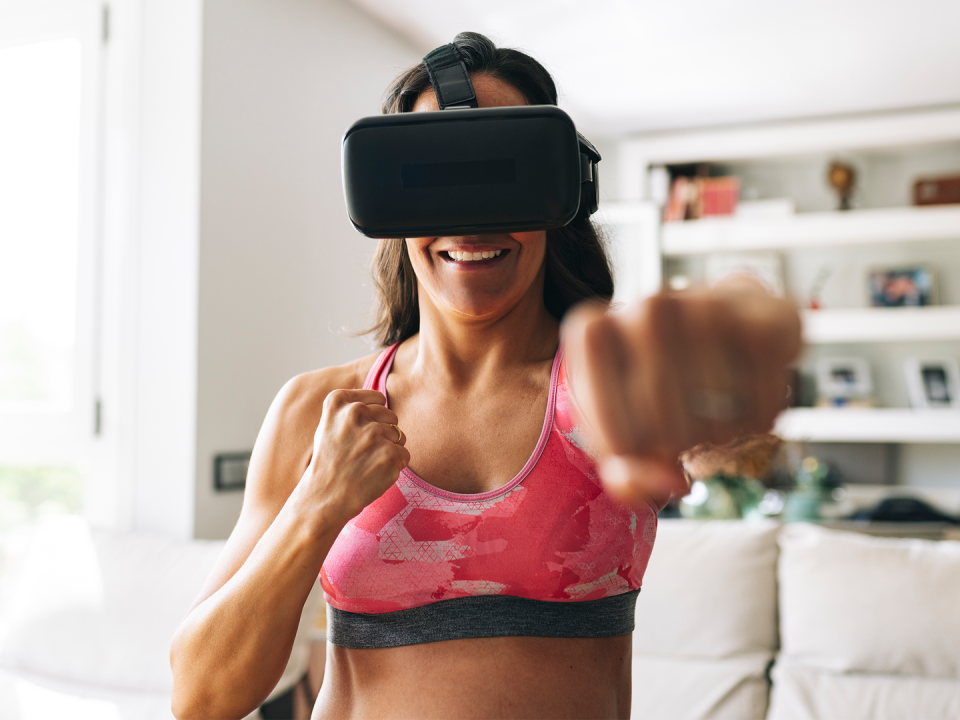
According to its proponents, gamified fitness allows you to get in a physically demanding session from the comfort of your own home. You can easily fit it in around your schedule and it’s a genuinely fun way to get your cardio fix, unlike slogging it out on a treadmill.
There’s plenty of evidence to back up the benefits. One review found that participants who engaged in VR workouts experienced significant improvements to their cardiovascular fitness, body composition, balance and even muscle strength.
Then there are the psychological advantages. According to research by the British Journal of Health Psychology, VR makes exercise more enjoyable, less mentally challenging and easier to stay consistent with, while another study found it encourages people to push harder because they often underestimate how much energy they’re exerting.
Sounds brill, but I was still sceptical as to whether exergaming could get me working as hard as my usual sweat-inducing F45 sessions. To find out, I bid farewell to the gym and switched to VR workouts for a week.
Scroll on for my Meta Quest 2 review to find out what happened when I donned my VR goggles and got my sweat on...
What do you need for VR fitness?
To get started, you’ll need a VR headset such as the Meta Quest 2. It’s a standalone headset (no wires or computer connection required) that comes with everything you need to get going – a set of goggles, two motion-sensing controllers and a charger.
To keep you safe and ensure you don’t end up punching a wall or bashing your leg on a coffee table, Meta suggests you have a two-metre square space in which to play.
Previously, these next-gen devices would set you back over a grand, but as they’ve become more ubiquitous, they’ve dramatically dropped in price. You can now pick up the Meta Quest 2 for under £400. Admittedly, this isn’t cheap, but it's more affordable than lots of smart home workout equipment and pricey gym memberships.
Is the Meta Quest 2 worth it?
Our experts at the Women’s Health Lab put the viral headset to the test, judging it on design, instructions, ease of use and performance, before awarding a final score.
Here’s everything you need to know before you *add to basket*.
Design
Score: 4.6/5
The Meta Quest 2 scored top marks for design. The headset is lightweight (it’s 10% lighter than its predecessor and less bulky than other VR devices out there), comfortable and aesthetically pleasing.
The elasticated straps were easy to adjust to ensure the right fit and the foam padding around the eyes meant the headset didn’t rub or feel painful – just make sure it isn’t too tight ahead of long sessions to avoid red goggle marks. We also found the foam picked up dirt easily, so we’d recommend wiping it down after use.
The controllers felt comfy in our hands and the buttons were well-placed and intuitive to use. We appreciated the ties around the wrist for added security, particularly handy for high-intensity workouts.
The plastic design means it’s a doddle to clean, but we would have liked a storage case to pack the headset and accessories away neatly.
Set up and instructions
Score: 4/5
The set-up process is relatively faff-free, with minimal but useful instructions to help you get started. There are no wires to plug in or sensors to arrange; you have everything you need to get set up on the headset.
You simply put the headset on, activate your account on the Meta mobile app, establish your space boundaries and floor height, and you’re good to go. There’s an intro video showing you how to use the controllers, safety demos and instructions on how to navigate the menus.
Once set-up is complete, you can access the menu to browse and download games and connect with other players. We found this relatively simple, although those who are less tech-savvy may benefit from extra guidance.
Ease of use
Score: 4.6/5
Once we were familiar with the device, using the headset was, on the whole, straightforward.
We rated the safety warnings, which let you know if you’re in danger of bumping into objects nearby, and liked that it switches to augmented reality when you put the controllers down, so you know what you’re doing.
At times, it was a tad confusing knowing which controller to use or what button to press, but we got the hang of it the more we used it. Additionally, when we experienced any glitches, it wasn’t initially obvious how to resolve them. Clearer guidance on how to access tech support would have been beneficial.
Performance
Score: 4.2/5
We were mega impressed with the Meta Quest 2’s performance overall. On test, it provided a totally immersive, 360-degree virtual reality experience that transported us into a whole new world. We also enjoyed the community element, which allows you to work out with people around the globe.
The fitness games we tried – FitXR and Guided Tai Chi –ran smoothly, with very little lagging, while the picture quality was excellent and the built-in speakers offered a crisp, clear sound. If you do want to make the experience even more immersive, you can plug in your headphones.
Overall score: 87/100
What’s the best workout in VR?
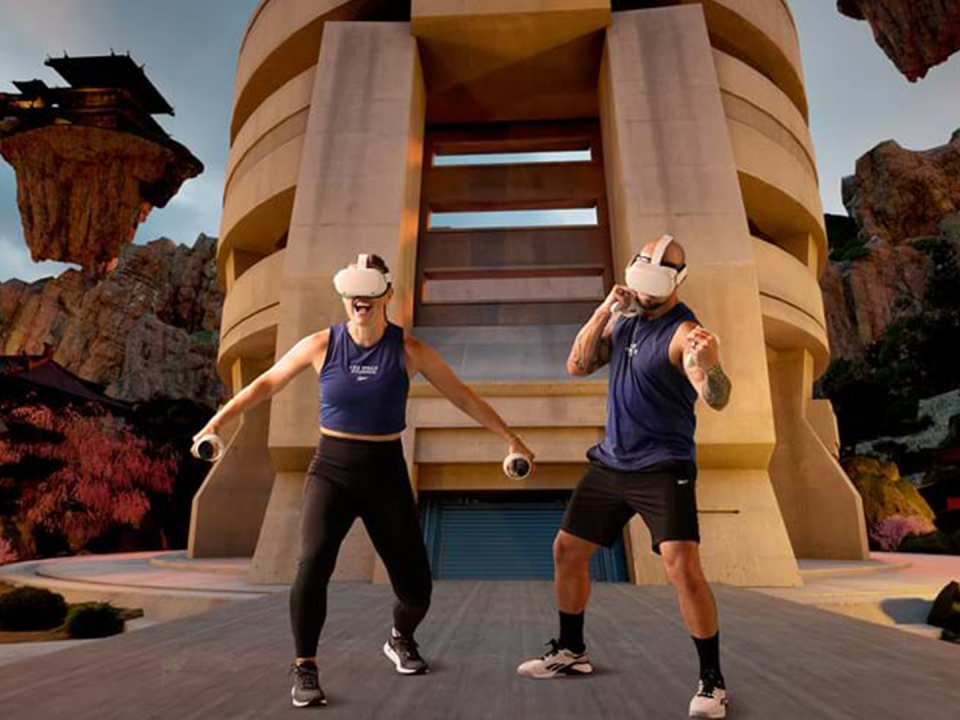
The Quest 2 has a sizeable library of fitness games spanning HIIT, dancing and boxing workouts. For my week-long challenge, I decided to give Les Mills’ award-winning Body Combat app a whirl. Based on the brand’s popular martial arts workout concept, it combines boxing, Muay Thai and karate moves to pumping background music, and involves crushing flying objects with your jab-hook combo as they hurtle towards you.
There are 30 cardio sessions suitable for all levels, tutorials to help you nail your technique and enthusiastic coaching via 3D scans of personal trainers Dan and Rachael. The workouts vary from speedy five-minute HIIT bursts to longer 25-minute power conditioning sessions, with plenty of upper and lower body variations and low-impact options.
For those who like to track their progress or have a competitive edge, there’s a leaderboard where you can compete against other players and see your stats post-workout, including overall points scored, accuracy, average punching power and calories burned.
Unlike many apps that require monthly subscriptions, Body Combat VR is a one-time purchase, costing £22.99.
5 things I learnt from working out in the metaverse for a week
1. Virtual workouts are no joke
After following the beginner tutorials on the Body Combat app to perfect my jabs, crosses and uppercuts, I was ready to dive in. Ever the sceptic, I didn’t think it would feel like a *proper* workout, so I wore PJs and a hoodie for my first session, a ‘full body hype’ class.
20 minutes of punching, ducking and diving later, I seriously regretted my decision. I was dripping in sweat and according to my Apple Watch, my heart rate had reached 155bmp. Not bad!
I had also, incorrectly, assumed my upper body would be doing all the work, but I wasn’t just using my right hook to punch the targets. There was a lot of core, leg and glute work involved and I had to dodge, duck and weave, avoiding large obstacles that came whizzing towards me.
After a couple of back-to-back classes, I could feel my shoulders burning and my quads were on fire. Turns out, you can get a proper heart-pounding workout to rival a cardio class in the metaverse.
2. Time flies when you’re having fun
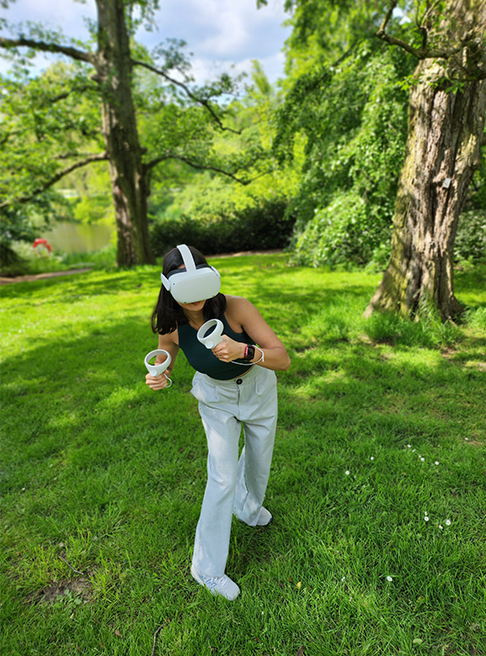
As much as I enjoy my regular exercise routine, which consists of F45 classes, running and yoga, I do have to psych myself up before a cardio session. When I finally get started, there’s often a lot of clock-watching involved. There were no such problems during my week of exergaming – even when my heart rate was soaring and I was panting for breath, I didn’t feel like I was doing a workout; it felt more like playing a game.
I found myself bouncing out of bed earlier than normal to strap on my goggles and start firing off jabs and knee strikes. I racked up at least an hour in the metaverse each day because I was having so much fun. It was honestly a revelation!
3. Exergaming is super convenient
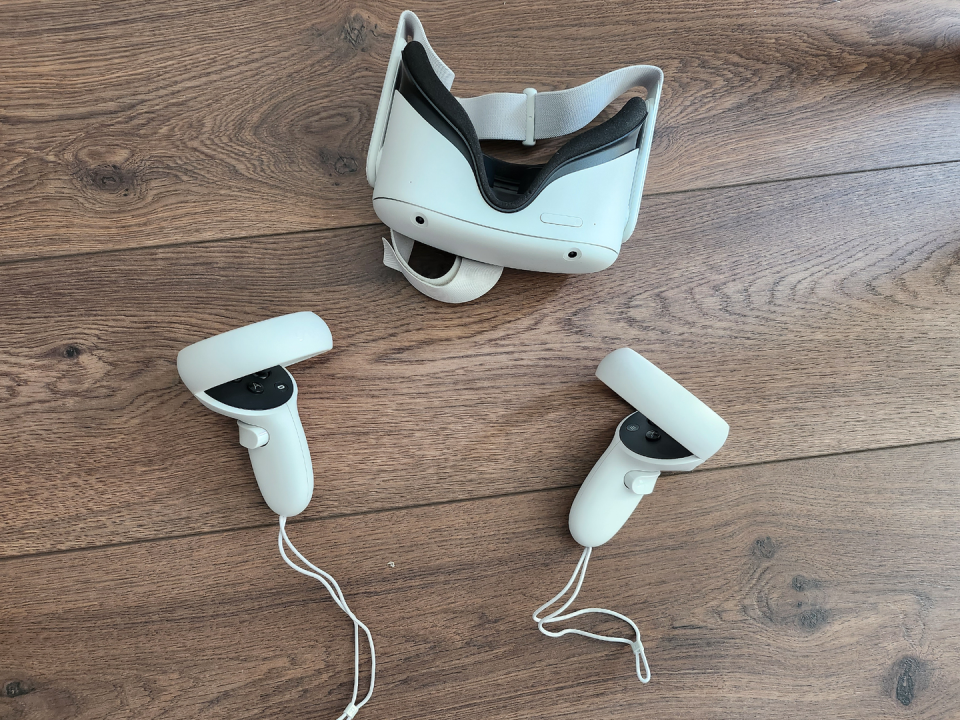
In the same vein, I found it easy to fit my VR workouts in around my hectic schedule. You don’t need to gather heaps of equipment and there are lots of short, snappy options on the Body Combat VR app, so I could easily squeeze in 10 minutes on my lunch break.
Top tip: avoid the high-impact classes if you don’t want to end up a sweaty mess before an afternoon meeting. I learnt the hard way...
I was worried about fitting in a session on the Meta Quest 2 during my jam-packed weekend, but I shoved it in my tote bag (it’s not very heavy) and took it to the park to meet my friends. Over the course of the afternoon, I managed to do 45 minutes of alfresco boxing in the sun, and it was glorious.
4. VR provides a safe, judgement-free space for exercise
I usually avoid classes that involve boxing because my coordination is shocking, and I worry about embarrassing myself, but having the VR headset allowed me to give it a go without any fear of judgement.
Turns out, I really enjoy boxing. It gives me a massive endorphin boost, a head-to-toe burn, and helps me focus my anxious mind. Practising in virtual reality has given me the confidence to attempt a real-life boxfit class, and I’m incredibly grateful for that.
Exercising in VR was also great for days when I wasn’t feeling my body confident best. With the goggles strapped to my head, I wasn’t thinking about what I looked like or comparing myself to others; I could just focus on moving my body.
More generally, it also provided an escape from any overwhelming or negative thoughts spinning in my head – with so much going on, you have to be totally present in what you’re doing.
5. Gamified fitness isn’t a gym replacement
Despite my newfound love for VR fitness, by the end of the week, I was starting to miss the gym. I enjoy lifting weights and feeling strong, but unfortunately, flinging around dumbbells with a headset on isn’t possible with the existing technology.
For me, the main downside of gamified fitness is that strength training is off the cards. As such, I don’t think it’s a fully-fledged gym replacement, but more of a tool to supplement my existing training when life gets in the way, I can’t muster up the energy to make it to a class or I’m travelling and don’t fancy hitting up a dingy hotel gym.
Final verdict
After seven days of working out in virtual reality, I can safely say it’s not a gimmick, but a legitimate – and seriously enjoyable – way to get your body moving.
I had a blast using the Les Mills Body Combat app – the workout options were fun, varied and most definitely got my heart pumping. I thoroughly enjoyed throwing punches to the upbeat music and I loved the leaderboard element to feed my competitive nature.
Hearing the same audio cues and one-liners from the coaches on repeat did get a tad irritating after a while (an option to turn them off would have been appreciated) and I would have liked a few more dreamlike environments to immerse myself in, but those were my only real niggles. And, when you consider the one-off price, it feels like excellent bang for your buck.
I’d say the Meta Quest 2 is a particularly worthy investment if you don’t enjoy typical forms of exercise, feel uncomfortable in a gym setting or have trouble motivating yourself to exercise. After all, you’re more likely to stick to a fitness regime if you actually enjoy what you’re doing.
As for me, although I won’t be getting my sweat on in the metaverse on the daily anymore, I will undoubtedly continue using VR workouts as an additional way to fit in exercise around my gym sessions. They’re a total game-changer.
You Might Also Like

 Yahoo Sport
Yahoo Sport 





































